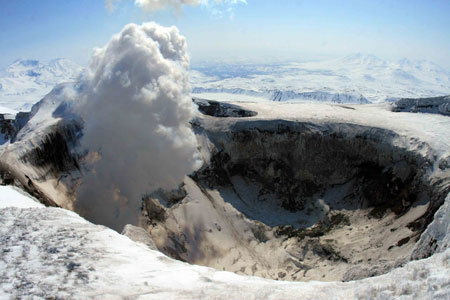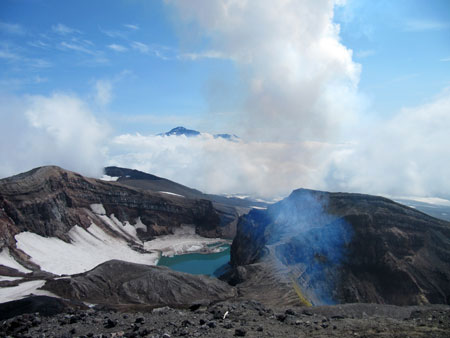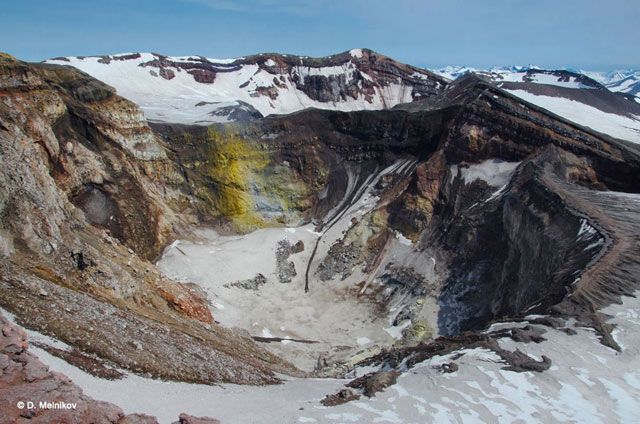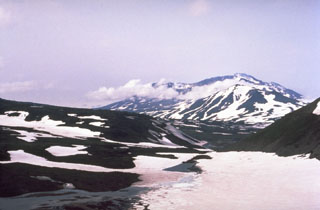Report on Gorely (Russia) — July 2013
Bulletin of the Global Volcanism Network, vol. 38, no. 7 (July 2013)
Managing Editor: Richard Wunderman.
Gorely (Russia) Seismicity above background in post-eruptive phase to July 2012
Please cite this report as:
Global Volcanism Program, 2013. Report on Gorely (Russia) (Wunderman, R., ed.). Bulletin of the Global Volcanism Network, 38:7. Smithsonian Institution. https://doi.org/10.5479/si.GVP.BGVN201307-300070
Gorely
Russia
52.5549°N, 158.0358°E; summit elev. 1799 m
All times are local (unless otherwise noted)
Our last Bulletin report summarized Kamchatka Volcanic Eruptions Response Team (KVERT) reports on eruptive activity at Gorely through 30 July 2010 (BGVN 35:07); MODVOLC was covered through 3 August 2010. In this report we note subsequent MODVOLC alerts for 10, 15, and 19 August 2010. KVERT reported that satellite-based thermal anomalies were detected on 10-12, 15, and 23 August 2010. During July and August 2011, reports noted red incandescence. This report covers activity through 6 July 2012. The Aviation Color Code remained at Yellow throughout the reporting period, indicating signs of elevated unrest above known background levels.
Our sampling of available KVERT data revealed that for the remainder of 2010, seismicity was above background levels, with continued recording of volcanic tremor. Weak or moderate gas-and-steam activity of the volcano was observed periodically; clouds obscured the volcano on the other days. According to satellite data analysis, a thermal anomaly was registered over the volcano periodically for the remainder of 2010; on 12-14 and 18 November 2010. On 12 November, a gas-steam plume extended about 40 km NE.
KVERT reported predominantly moderate seismicity, with continued recording of volcanic tremor through 2011. Periodic weak thermal anomaly over the volcano continued to be noted in satellite images. Moderate and strong gas-and-steam activity at the volcano was observed on 1-3, and 5 April. The lake in the active crater of the volcano disappeared (figure 7).
 |
Figure 7. Moderate-to-strong gas-and-steam activity at Gorely on 24 April 2011. Photo courtesy of A. Nuzhdaev. IVS FEB RAS. |
According to satellite data on 5 May 2011, a weak thermal anomaly was registered over the volcano, and a gas-and-steam plume extended about 15 km W. During 11-12 June, according to visual data, a red incandescence was observed in the new fumarole vent within the active crater, and the lake remained absent. During 7-8 July, the incandescence continued. Moderate fumarolic activity was observed on 20 July. On 26 July, observers noted a new lake within the active crater, including blocks of ice on the lake's surface (figure 8). The new fumarole was covered with colluvium, but red incandescence was seen within the vent. During 6-9 August these blocks of ice on the lake's surface were melting.
 |
Figure 8. Photo at Gorely on 9 August 2011 shows a new lake within the active crater. Courtesy, Yu. Nazimova. |
Moderate seismic activity continued during the remainder of 2011, along with volcanic tremor. According to satellite data, thermal anomalies were registered on 26 and 29 August; 4-5 September; 5, 11-12, 21-25, and 31 October; 1-2, 5, 13, 24, 27-28 November; 2, 7, 20 December. Strong and moderate gas-and-steam activity was observed during 22-23 and 29 December. A large thermal anomaly was detected during 29-30 December 2011.
Seismic activity at Gorely increased in early January 2012 and continued to be elevated through February, but ceased being recorded after 5 February after a technical dysfunction. About 20-30 seismic events were registered within the volcanic edifice during 2-3 January. According to visual data, strong and moderate gas-and-steam activity was observed throughout January and February. Gas-and-steam activity became more moderate in March and continued at that level through the end of June.
Thermal anomalies were registered by satellite images during 1-2, 6-8, 17, 23, 28, and 31 January; 2, 4-5, 7, 11, and 19-21 February; 24 March; 10, 15, 17, 24, and 28 April; 2, 3, 10, 11-13, 15, 22 and 30 May; 21 and 29 June. Visual observations on 12 May revealed that the bottom of the active volcanic crater was covered by snow, but strong fumarolic emissions persisted (figure 9). A gas-and-steam plume was seen rising to 4 km (a.s.l.) During 16-17 June.
 |
Figure 9. Bottom of active crater at Gorely on 12 May 2012, showing strong fumarolic emissions. Courtesy, D. Melnikov, IVS FED RAS. |
Between 28 June and 1 July 2012, seismicity was recorded at above background levels; continuous spasmodic tremor was detected on 28 and 30 June, and on 1 July 2012.
Geological Summary. Gorely volcano consists of five small overlapping stratovolcanoes constructed along a WNW-ESE line within a large 9 x 13 km caldera. The caldera formed about 38,000-40,000 years ago accompanied by the eruption of about 100 km3 of tephra. The massive complex includes about 40 cinder cones, some of which contain acid or freshwater crater lakes; three major rift zones cut the complex. Another Holocene stratovolcano is located on the SW flank. Activity during the Holocene was characterized by frequent mild-to-moderate explosive eruptions along with a half dozen episodes of major lava extrusion. Early Holocene explosive activity, along with lava flows filled in much of the caldera. Quiescent periods became longer between 6,000 and 2,000 years ago, after which the activity was mainly explosive. About 600-650 years ago intermittent strong explosions and lava flow effusion accompanied frequent eruptions. Historical eruptions have consisted of moderate Vulcanian and phreatic explosions.
Information Contacts: Kamchatka Volcanic Eruptions Response Team (KVERT), Far East Division, Russian Academy of Sciences, 9 Piip Blvd., Petropavlovsk-Kamchatsky, 683006, Russia (URL: http://www.kscnet.ru/ivs/); Sergey Senukov, Kamchatka Branch of the Geophysical Service of the Russian Academy of Sciences (KB GS RAS), Russia (URL: http://www.emsd.ru/); Alexander Ovsyannikov, Sergei Chirkov, and Anatolii Mushinsky, IV&S FED RAS; and Hawai'i Institute of Geophysics and Planetology (HIGP) Thermal Alerts System, School of Ocean and Earth Science and Technology (SOEST), Univ. of Hawai'i, 2525 Correa Rd, Honolulu, HI 96822, USA (URL: http://modis.higp.hawaii.edu/).

